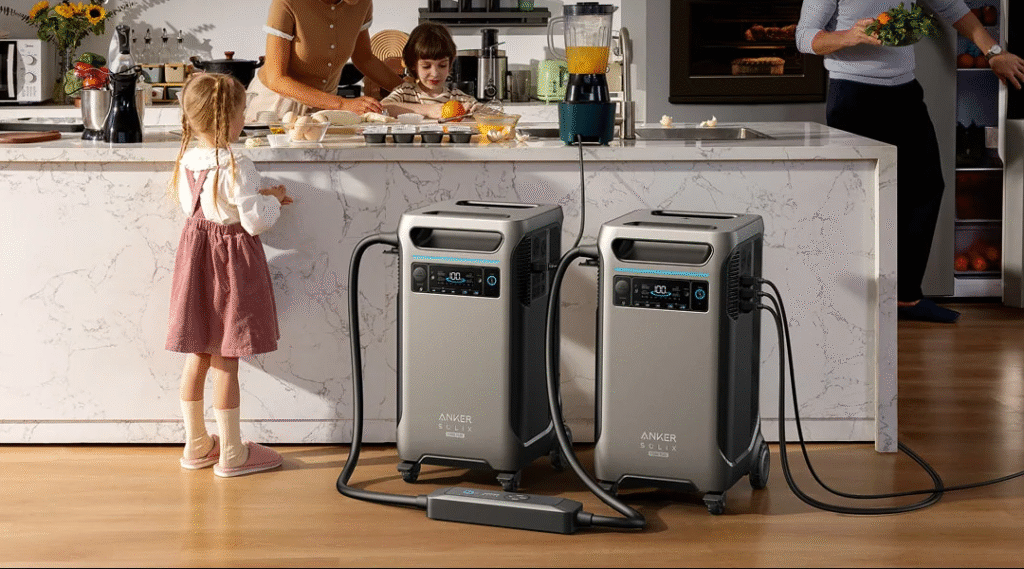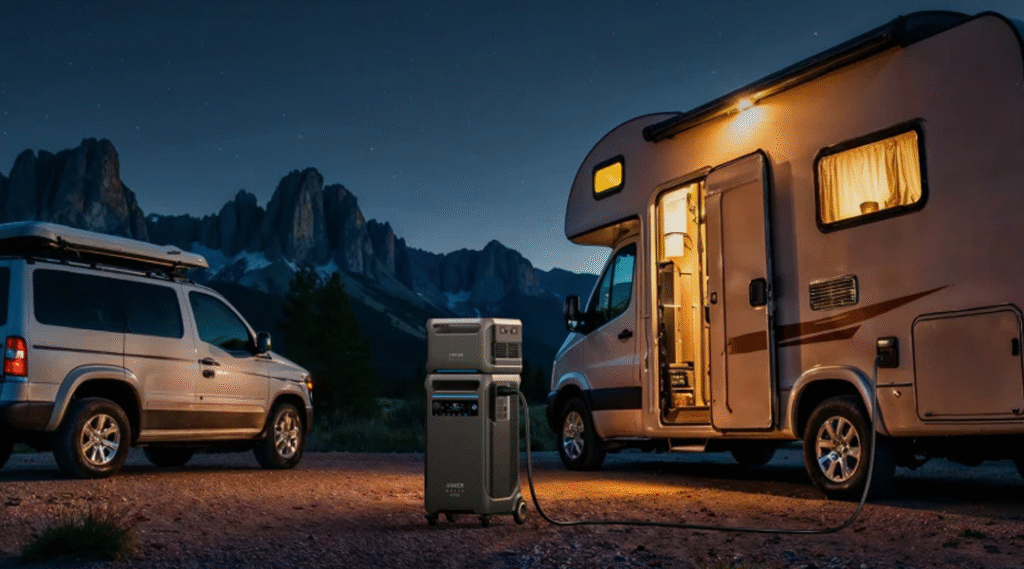Anker’s SOLIX F3800 Plus positions itself as a near-turnkey whole-home backup in a market where users increasingly weigh power, longevity, and expandability against sticker shock. Priced at $4,799 for a single unit, the F3800 Plus targets homeowners and serious off-grid users who want robust AC output, fast solar recharge, and EV-grade LiFePO₄ chemistry. Here’s a professional breakdown of whether that price is justified.
Core specs that drive value
The base unit offers 3,840 Wh of LiFePO₄ battery capacity paired with a 6,000 W continuous (9,000 W surge) dual-voltage inverter (120/240 V), making it capable of powering large appliances — refrigerators, well pumps, even central AC when configured with expansion batteries. It supports up to 3,200 W of solar input (dual 165 V MPPT) and claims rapid solar recharge under optimal conditions. The battery chemistry provides 3,000+ cycles to 80% and Anker backs the product with a 5-year warranty, positioning the product for a long operational life. These specs are the primary reasons buyers consider this class of product.
How the economics stack up
At $4,799 for 3,840 Wh, the raw purchase price equates to about $1.25 per Wh of installed capacity. If you amortize that upfront cost over the product’s rated 3,000 cycles (a simplified lifetime model), the cost per kWh delivered over the battery’s life is roughly $0.42/kWh — a rough back-of-the-envelope that excludes inverter losses, maintenance, and time value of money but still useful for comparison. When you add the possibility of a 30% Residential Clean Energy tax credit (for eligible installations), the effective up-front cost can drop materially for qualified buyers, improving value for whole-home backup buyers.
Real-world strengths
- High continuous and surge power. The 6,000 W continuous / 9,000 W surge rating makes the unit genuinely capable of running major household loads that many portable power stations cannot. That capability changes the value proposition from “emergency phone charging” to “real backup for a home.” (Anker Solix)
- LiFePO₄ durability. 3,000+ cycles to 80% gives a long effective life (10+ years claimed), which is important where replacement cost and lifecycle matter. (Anker Solix)
- Fast solar and flexible recharging. Up to 3,200 W solar input and multiple recharge paths (solar, AC, generator, car) reduce reliance on the grid and shorten downtime after an outage.
Trade-offs and limitations
- High initial outlay and heavy weight. At nearly 132 lb and large physical dimensions, the F3800 Plus is not portable in the conventional sense; installation, placement, and possibly an electrician will be needed if you adopt it as a home backup. The upfront $4,799 is significant compared with consumer-grade portables.
- System complexity. To achieve multi-day backup (or full-home coverage), you’ll likely need expansion batteries and possibly the home backup kit or professional installation, which add cost — the site lists bundled options up to several thousand dollars extra. Factor those into your total project cost. (Anker Solix)
- Net cost vs. alternatives. For buyers who only need to run essentials (router, lights, fridge) for a day or two, cheaper, smaller solutions will provide better immediate ROI.
Who should buy it?
The F3800 Plus is worth the price for homeowners who want a durable, expandable, high-power backup system and who value long battery life and rapid solar recharge. It’s especially compelling if you can claim the Residential Clean Energy tax credit, plan to expand capacity, or need 240 V / NEMA outputs for RVs or large appliances. For buyers who need lightweight portability or only occasional, low-power backups, the cost and size make it overkill.
Final point
The Anker SOLIX F3800 Plus is priced accordingly for what it delivers: whole-home level inverter capacity, robust LiFePO₄ longevity, high solar input, and modular expandability. If your priority is reliable multi-appliance backup and a system you can scale over years — and you can absorb the upfront cost (or leverage incentives) — it’s a defensible investment. If you only need occasional, small-scale backup, you’ll find better value in smaller, less expensive units.

Before making the final decision, the following assumption you should read
We ran the numbers and estimated how long an Anker SOLIX F3800 Plus (3,840 Wh / 6,000 W) will run common appliances. We pulled specs from Anker’s product page and then calculated runtimes under a few conservative-to-optimistic assumptions. Source: Anker product page.
Summary first
- The F3800 Plus has 3,840 Wh nominal capacity and 6,000 W continuous / 9,000 W surge inverter, so it can handle motor starts (fridges, A/C) and sustained heavy loads.
- Runtimes depend heavily on how much of the battery you use and inverter losses. Below are three realistic scenarios (conservative → optimistic) and run-time estimates for typical loads.
Assumptions used
- Conservative: usable = 80% depth-of-discharge (DoD) × 90% inverter efficiency → usable ≈ 2,765 Wh.
- Moderate: usable = 90% DoD × 90% inverter efficiency → usable ≈ 3,110 Wh.
- Optimistic: usable = 100% DoD × 95% inverter efficiency → usable ≈ 3,648 Wh.
(These cover practical user choices: some prefer to limit DoD for longer battery life; LiFePO₄ makes deeper cycles safer than other chemistries.)
Typical appliance runtimes (hours)
(Results = usable Wh ÷ appliance continuous wattage; computed precisely.)
| Conservative | Moderate | Optimistic |
|---|---|---|
| Efficient fridge (100 W) — 27.7 h | 31.1 h | 36.5 h |
| Typical fridge (150 W) — 18.4 h | 20.7 h | 24.3 h |
| Large fridge (300 W) — 9.2 h | 10.4 h | 12.2 h |
| Chest freezer (200 W) — 13.8 h | 15.6 h | 18.2 h |
| Small A/C (800 W) — 3.5 h | 3.9 h | 4.6 h |
| Medium window A/C (1,200 W) — 2.3 h | 2.6 h | 3.0 h |
(If you prefer a single-number quick reference: under “moderate” assumptions, expect ~20–31 hours for refrigerators and ~3.9 hours for an 800 W small A/C running continuously.)
Expansion battery example
Anker’s expansion option doubles capacity (7,680 Wh). Using the same moderate assumption (90% DoD × 90% inverter), the usable capacity ≈ 6,221 Wh. That yields, for example:
- Typical fridge (150 W): ~41.5 hours
- Small A/C (800 W): ~7.8 hours
Practical notes you should consider
- Start-up (surge) vs continuous draw: The F3800 Plus supports 9,000 W surge, so compressor start peaks are usually handled, but continuous loads must remain ≤ 6,000 W.
- Duty cycle matters: Refrigerators/AC don’t run 100% of the time. A fridge’s “average” continuous draw used above already accounts for compressor cycling. If you know your appliance’s nameplate running watt or measured average, plug that in for better accuracy.
- Solar / recharge: With up to 3,200 W solar input (and Anker’s claim of full recharge in ~1.5 hr under ideal sun), you can significantly extend runtime during daylight or top the battery off between outages.
- Real-world losses: Additional parasitic draws (Wi-Fi, UPS mode inefficiencies, inverter heat) and ageing will reduce run times slightly over years.
- Installation & scaling: Adding expansion packs or using the Home Power Panel changes the use-case (multi-day backup, whole-home scenarios).
More articles for the relative topic:
Home Energy Storage: A Comprehensive Deep Dive
Is the 2025 BMW X3 xDrive30 a Smart Buy? A Clear and Practical Look
Are the Ray-Ban Meta Wayfarer Gen 2 AI Glasses the Right Products to Buy?
Choosing Between Size and Sound: Nest Mini vs Nest Audio
As for in-depth insight articles about AI tech, please visit our AI Tech Category here.
As for in-depth insight articles about Auto Tech, please visit our Auto Tech Category here.
As for in-depth insight articles about Smart IoT, please visit our Smart IoT Category here.
As for in-depth insight articles about Energy, please visit our Energy Category here.
If you want to save time for high-quality reading, please visit our Editors’ Pick here.



